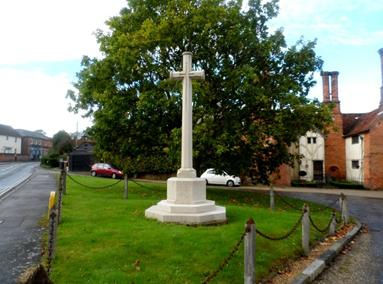
Hugh
Gordon Muschamp
VICKERS
1886 –1918

Early Life
HUGH GORDON MUSCHAMP VICKERS was born on the 18 May 1886 in Mitcham, Croydon, Surrey, the fourth son of James Muschamp and Annie Elizabeth Vickers (née Bainbridge).
His parents were married on the 9 December 1874 at Castle Ward, Northumberland. Hugh’s father was a student of the Inner Temple in May 1881 and called to the Bar on the 7 May 1884. He was the Justice of the Peace in Hong Kong for several years. Annie was the daughter of Emerson Muschamp Bainbridge, a mining consulting engineer, philanthropist and Liberal Party politician who sat in the House of Commons from 1895 to 1900. Emerson lived at Eshott Hall, Nr Felton, Northumberland and was the founder of the world’s first Department Store, Bainbridges, in Newcastle, which later became part of the John Lewis Partnership.
Hugh was the youngest child, his three elder brothers were Emerson Muschamp, born 5 Feb 1876 in Shanghai, China, where his parents were living at the time, who died 26 July 1889, aged 13 years, in Eastbourne, Hubert James Muschamp, b. 31 Aug 1878 at Dissington Hall, Newcastle who died 25 Dec 1879, aged 3 years, at Mitcham, Surrey and Noel Muschamp, born 22 December 1880 at Mitcham. Hugh’s elder and only sister was Maud Muschamp, b.21 Apr 1877 at Penge, Surrey.
In 1891 the family were living at The Grove House, at Mitcham and in the early 1890’s, the family moved to Waltham House, Howe Street, Great Waltham and was recorded on the 1901 Census as having four servants.
By 1901, Hugh is shown as a Boarder at Harrow School, aged 14 years. On the 15th October1904 he matriculated at New College, Oxford University and had the degree of BA conferred on the 18th November 1908. He undertook the following examinations:
Responsions in September 1904. First Public Examinations: In Sacra Scriptura in Trinity term 1905 and in Graecis et Latinis in Hilary term 1906. Second Public examinations: in the final honour school of Literae Humaniores (Classics) for which he attained third class in Trinity term 1908.
Hugh’s father James died on the 4 June 1909 after a serious illness at home in Great Waltham and the funeral and burial took place in the Great Waltham Church on the following Tuesday, the 8 June.
On the 19th October 1910 Hugh joined the India Civil Service and ten days later, on the 29th October set sail, first class, from London for Calcutta on board the “Sicillia”.
He remained in India for four and half years as Assistant Commissioner in Eastern Bengal and Assam.

Military Life
On the 18th May 1915, Hugh was promoted to 2nd Lieutenant in the Cavalry Branch. As soon as his services could be spared Lieutenant Vickers, who belonged to the 16th Cavalry, Indian Army, R.O., and was subsequently attached to the 13th Duke of Connaught’s Own Lancers(Watson’s Horse), went to the Front in Mesopotamia in January 1917.
In July 1916, the Lancers moved to Mesopotomia for the relief of Kut-al-Amara and Hugh, who was probably involved in the final action, fought at the Battle of Sharqat, which saw British regional Commander in Chief Sir William Marshall secure control of the Mosul oilfields north of Baghdad. The orders were to remove as much remaining Turkish influence from the region as possible in the weeks immediately prior to the anticipated Turkish armistice, as had previously been achieved in Palestine.
Sir Alexander Cobbe was commanded to lead a combined Anglo-Indian force from Baghdad on 23 October 1918. Its progress was remarkably swift: within two days it had covered 120km, reaching Little Zab River, where it expected to meet and engage the Turkish Sixth Army operating under Ismail Hakki Bey.
However Hakki determined to retreat his army once it became clear that Cobbe's force was endangering his army's rear. Retreating therefore to Sharqat a further 100km to the north, he nevertheless came under attack by Cobbe on 29 October 1918.
Within a day Hakki surrendered to Cobbe, despite the fact that his lines had yet to be breached by the combined Anglo-Indian force. However with the Ottoman Empire in disarray an armistice was both desirable and imminent, and was consequently agreed within a matter of days. During this last battle in Mesopotamia 18,000 Turk soldiers were taken prisoner by the British, whose losses ran to a little under 2,000 men.
Death and Memorial
Hugh, now a Lieutenant, was killed in action on the 30th October 1918, in the last hour of the fighting against the Turks, whilst rounding up a convoy on the Mosul Road, near Quaiaragh, Mesopotamia.
A letter to his sister Maud, states –
“I know it will cheer you up to know that your brother was killed in the way I am sure he would have wished, doing his duty as a gallant soldier. Vic (his name in the Regiment) was in my Squadron for about a year and a half, and apart from being my Subaltern was a great pal of mine, and I can’t tell you how much I and all of us miss him. We were charging a Turkish force, and although I was not with him at the moment he was shot I was with him immediately afterwards.”
The Assam Gazette, dated November 1918 wrote:
“The Chief Commissioner has learned with great regret that Mr H G M Vickers, ICS, a Lieutenant in the Indian Army, Reserve of Officers, attached to the 13th Lancers, was killed in action on October 30th. Mr Vickers was a very keen and promising Officer, and also a good rider and sportsman, who joined the Army as soon as he could be spared from his civil duties. His death will be widely mourned by his many friends.”
Hugh was buried at Baghdad (North Gate) War Cemetery in Iraq and is also remembered at several other locations –

-
All Saints Cathedral (New Church) Meghalaya, Shillong, India

2. Mitcham Church Road Burial Ground, Surrey.



